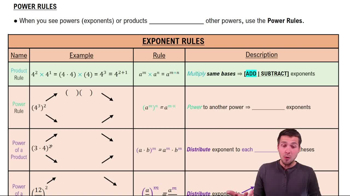Here are the essential concepts you must grasp in order to answer the question correctly.
Chain Rule
The chain rule is a fundamental technique in calculus used to differentiate composite functions. It states that if a function y = f(g(x)) is composed of two functions, the derivative y' is found by multiplying the derivative of the outer function f with respect to the inner function g by the derivative of the inner function g with respect to x. This rule is essential when dealing with nested functions, such as y = (1 − √x)⁻¹.
Recommended video:
Power Rule
The power rule is a basic rule for differentiation that applies to functions of the form y = x^n, where n is any real number. The derivative of y with respect to x is given by y' = n*x^(n-1). This rule is crucial for differentiating terms like (1 − √x)⁻¹, where the exponent is negative, and it helps simplify the process of finding the first and second derivatives.
Recommended video:
Second Derivative
The second derivative, denoted as y'' or d²y/dx², represents the derivative of the first derivative y'. It provides information about the concavity and inflection points of the original function y. Calculating the second derivative involves differentiating the first derivative, often requiring the application of rules like the chain rule and power rule multiple times, especially in complex functions like y = (1 − √x)⁻¹.
Recommended video:
The Second Derivative Test: Finding Local Extrema
 Verified step by step guidance
Verified step by step guidance Verified video answer for a similar problem:
Verified video answer for a similar problem:



 2:42m
2:42m